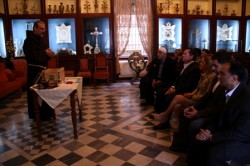On 10 October a precious object was donated to the Archaeological Museum of the Studium Biblicum Franciscanum.
It is an ancient stone die from Jerusalem used for the production of eulogias, displaying on each side Biblical scenes whose protagonists are the patriarch Abraham and the prophet Daniel. The eulogias were small flasks made of metal or ceramic designed to hold a small amount of oil coming from the lamps burning at the holy sites. Pilgrims, particularly those from the Eastern churches, liked to carry these eulogias with them as mementos of their voyage to the Holy Land.
This object, of great historical and artistic value, was found – according to the information at hand – several decades ago in Jerusalem, in the Siloam area, and has now been donated to the Archaeological Museum by a generous antique collector from Texas, Mr. Erich Spangenberg, through the active involvement of one of the most well-known antiquity dealers in the Old City of Jerusalem, who served as an intermediary.
To celebrate this event and to offer thanks to the donor, on 10 October a ceremony was held in the Mother-of-Pearl Hall at St. Savior’s Monastery. Present at the ceremony were Father Custos Pierbattista Pizzaballa, Father Eugenio Alliata, Director of the Archaeological Museum of the Studium Biblicum Franciscanum, and the donor and antiquarian with their respective families.
The object will enrich the already well-endowed collection of the Archaeological Museum, and will help to advance the project “Telling the Story of the Holy Land”, which is supported by ATS pro Terra Sancta. At the Archaeological Museum activities of data collection, cataloguing and preservation are continuing as part of this same project, with the ultimate objective of creating a modern museum center, for pilgrims, tourists, scholars and the local population, in order to make better known – through guided tours – the history of the Christian presence in the Holy Land and the experience of the Custody in preserving the traces of the presence of Christ and the first Christians.


















